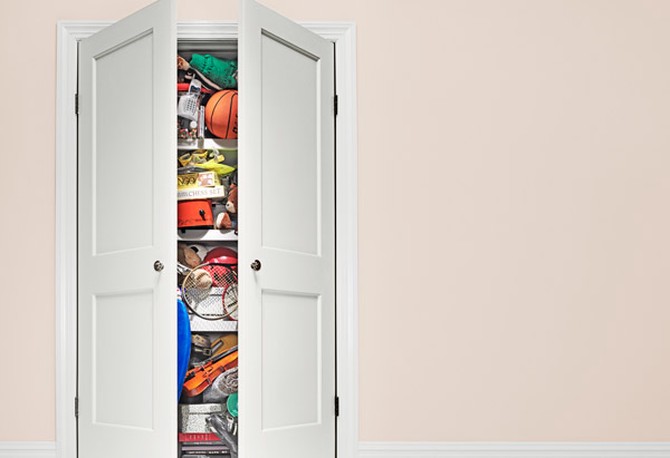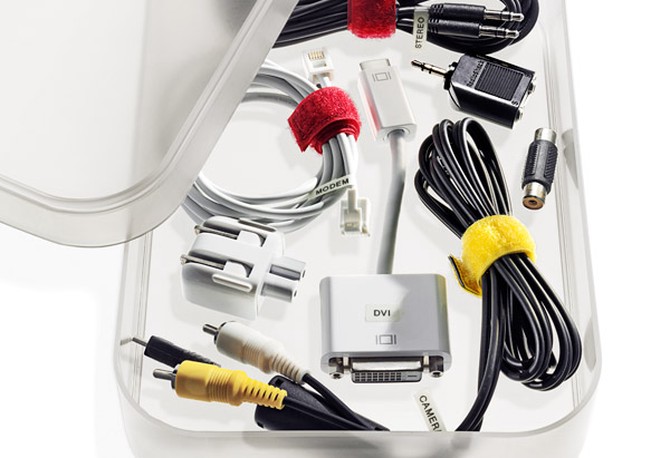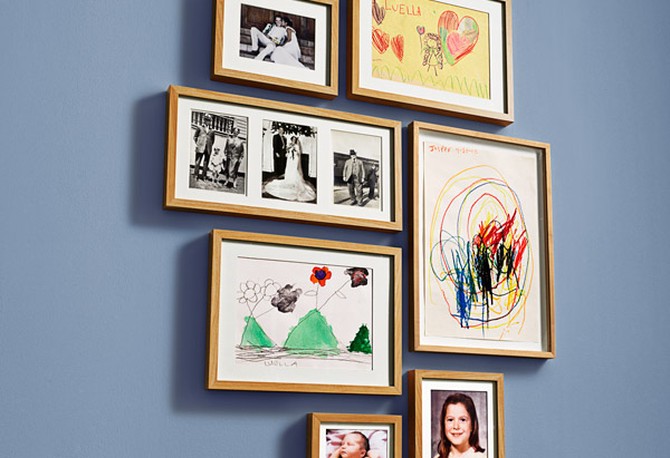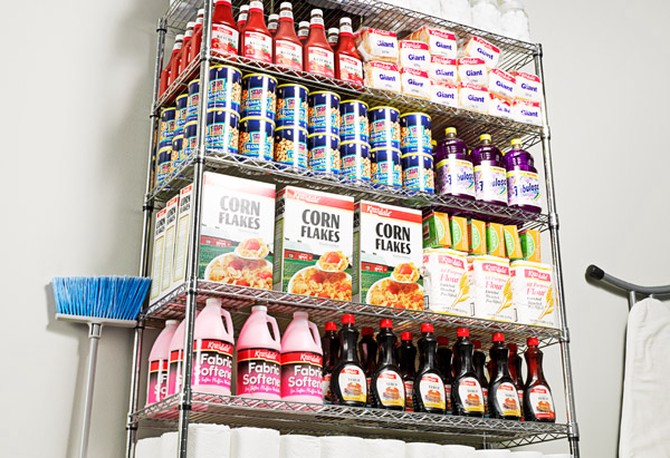What Kind of Clutterer Are You?
O's organizational expert, Peter Walsh, identifies five types of clutterers and helps each slay her mess.
By Meredith Bryan

Photo: Nigel Cox
The Behind-Closed-Doors Clutterer
Symptoms
Home looks pristine and well organized—until you start opening closet doors and are suddenly buried by file folders, moth-eaten coats, broken lamps, old kitchen appliances, paper towels, holiday decorations, and shopping bags full of purchases no one ever got around to returning. The BCD clutterer, Walsh explains, "lives in some flawless future universe instead of creating solutions that work today."
Perpetrators
Perfectionists, control freaks, harried working moms, anyone who's time-starved and overbooked; perfectionists.
1. Get over yourself.
"With clutter, the great is the enemy of the good," says Walsh. In other words, that injury-inducing hall closet is the manifestation of your shame at failing to live up to your own unrealistically high housekeeping expectations.
2. Start with small, manageable chunks.
"This type of clutter is about delayed decisions," says Walsh. If perfecting a chic shoe-organizing system or deciding which wedding gifts to return is too difficult, start with something less emotionally laden, like the tangle of paper clips overrunning your junk drawer. Better yet, confine the task to a time frame: I will clean this closet for exactly 15 minutes. The next day, repeat.
3. Enlist a friend.
If you can't find time to spontaneously tackle your secret messes, schedule it—and invite a trusted relative or friend to help. By ceding some control to an impartial outsider, you'll keep things in perspective and make the process much more fun. Are you really going to repair those cracked candelabras? And what on Earth are you still doing with that neon green '80s-issue ski jacket?
Next: The knowledge clutterer
Home looks pristine and well organized—until you start opening closet doors and are suddenly buried by file folders, moth-eaten coats, broken lamps, old kitchen appliances, paper towels, holiday decorations, and shopping bags full of purchases no one ever got around to returning. The BCD clutterer, Walsh explains, "lives in some flawless future universe instead of creating solutions that work today."
Perpetrators
Perfectionists, control freaks, harried working moms, anyone who's time-starved and overbooked; perfectionists.
Walsh's Three-Step Plan
1. Get over yourself.
"With clutter, the great is the enemy of the good," says Walsh. In other words, that injury-inducing hall closet is the manifestation of your shame at failing to live up to your own unrealistically high housekeeping expectations.
2. Start with small, manageable chunks.
"This type of clutter is about delayed decisions," says Walsh. If perfecting a chic shoe-organizing system or deciding which wedding gifts to return is too difficult, start with something less emotionally laden, like the tangle of paper clips overrunning your junk drawer. Better yet, confine the task to a time frame: I will clean this closet for exactly 15 minutes. The next day, repeat.
3. Enlist a friend.
If you can't find time to spontaneously tackle your secret messes, schedule it—and invite a trusted relative or friend to help. By ceding some control to an impartial outsider, you'll keep things in perspective and make the process much more fun. Are you really going to repair those cracked candelabras? And what on Earth are you still doing with that neon green '80s-issue ski jacket?
Next: The knowledge clutterer

Photo: Nigel Cox
The Knowledge Clutterer
Symptoms
Stockpiles every book she has ever read or hopes to read, and/or every issue of Architectural Digest ever published—believing, as Walsh explains, "that if she owns the book, then she somehow owns the knowledge, even if she never reads the book or takes it off the shelf." When she encounters an interesting article online, prints it and stashes it in an overstuffed file folder.
Perpetrators
Book club members; enthusiasts of coffee table tomes on interior design; recent college grads wanting to show off their feminist poetry collections.
1. Go digital whenever possible.
While nothing can replace a beloved, well-worn novel, "We have an entire library at our disposal nowadays via the Internet," says Walsh. "It's not necessary to own hard copies of everything." In other words, those guilty-pleasure page-turners, celebrity memoirs, and how-to books you'll read only once can live on your e-reader. And when you come across an interesting article online, e-mail yourself the URL and store these e-mails in folders labeled "interesting articles" or "weeknight dinner recipe
2. Manage magazines.
Certain issues (of O, for example!) you'll just want to hold on to forever. But if your living room is blanketed with weeklies dating to 2007, consider implementing a system: Keep the current issue and two back issues. As new titles arrive, donate the old ones to a local hospital. And remember: "The definition of a periodical is that there is always another one coming," Walsh says.
3. Establish clear limits.
Walsh suggests designating a clearly defined area for your book and magazine collection, whether that means one shelf or six. "What matters is that when you've filled the allotted area, you donate an old title to make room for any new ones," he explains. To prevent your nightstand from being swallowed by half-read paperbacks, try a bin or basket large enough to contain only three or four books; to add another, you must remove one first.
Next: The techie clutterer
Stockpiles every book she has ever read or hopes to read, and/or every issue of Architectural Digest ever published—believing, as Walsh explains, "that if she owns the book, then she somehow owns the knowledge, even if she never reads the book or takes it off the shelf." When she encounters an interesting article online, prints it and stashes it in an overstuffed file folder.
Perpetrators
Book club members; enthusiasts of coffee table tomes on interior design; recent college grads wanting to show off their feminist poetry collections.
Walsh's Three-Step Plan
1. Go digital whenever possible.
While nothing can replace a beloved, well-worn novel, "We have an entire library at our disposal nowadays via the Internet," says Walsh. "It's not necessary to own hard copies of everything." In other words, those guilty-pleasure page-turners, celebrity memoirs, and how-to books you'll read only once can live on your e-reader. And when you come across an interesting article online, e-mail yourself the URL and store these e-mails in folders labeled "interesting articles" or "weeknight dinner recipe
2. Manage magazines.
Certain issues (of O, for example!) you'll just want to hold on to forever. But if your living room is blanketed with weeklies dating to 2007, consider implementing a system: Keep the current issue and two back issues. As new titles arrive, donate the old ones to a local hospital. And remember: "The definition of a periodical is that there is always another one coming," Walsh says.
3. Establish clear limits.
Walsh suggests designating a clearly defined area for your book and magazine collection, whether that means one shelf or six. "What matters is that when you've filled the allotted area, you donate an old title to make room for any new ones," he explains. To prevent your nightstand from being swallowed by half-read paperbacks, try a bin or basket large enough to contain only three or four books; to add another, you must remove one first.
Next: The techie clutterer

Photo: Nigel Cox
The Techie Clutterer
Symptoms
Drawers, cabinets, and desk weighed down by a metastasizing tangle of cords, chargers, remotes, and half-full USB drives, many belonging to clunky devices dating to the '90s.
Perpetrators
Twenty- and 30-something Apple devotees; eBay enthusiasts; grandparents terrified to pitch the cord that connects their digital camera to their computer.
1. Banish boxes.
"There was a time when you could sell used electronics, so it made sense to keep the original packaging," says Walsh. Unfortunately, "no one wants your old gadgets anymore. Technology moves too fast." He recommends recycling an item's box within a month of purchase and donating old devices to a women's shelter. (When you move, pack your electronics in bubble wrap—or better yet, a towel.)
2. Label all wires.
With a label maker or small piece of masking tape, differentiate camera cords from BlackBerry chargers; note contents of all minidrives. If you're feeling ambitious, corral wires into a "charging station" to eliminate the nightly game of hide-and-seek with your phone cord.
3. Store smartly.
Walsh suggests labeling four shoebox-size containers "look," "listen," "travel," and "data," and placing them on a shelf. "Look" stores anything visual (the charger and memory card for your camera); "Listen", anything audio related (iPod accessories, an iPhone car charger); "Travel," anything vacation related (a portable GPS, plug adaptors); and "Data"—well, you get the picture (mini flash drives, a wireless network card).
Next: The sentimental clutterer/family historian
Drawers, cabinets, and desk weighed down by a metastasizing tangle of cords, chargers, remotes, and half-full USB drives, many belonging to clunky devices dating to the '90s.
Perpetrators
Twenty- and 30-something Apple devotees; eBay enthusiasts; grandparents terrified to pitch the cord that connects their digital camera to their computer.
Walsh's Three-Step Plan
1. Banish boxes.
"There was a time when you could sell used electronics, so it made sense to keep the original packaging," says Walsh. Unfortunately, "no one wants your old gadgets anymore. Technology moves too fast." He recommends recycling an item's box within a month of purchase and donating old devices to a women's shelter. (When you move, pack your electronics in bubble wrap—or better yet, a towel.)
2. Label all wires.
With a label maker or small piece of masking tape, differentiate camera cords from BlackBerry chargers; note contents of all minidrives. If you're feeling ambitious, corral wires into a "charging station" to eliminate the nightly game of hide-and-seek with your phone cord.
3. Store smartly.
Walsh suggests labeling four shoebox-size containers "look," "listen," "travel," and "data," and placing them on a shelf. "Look" stores anything visual (the charger and memory card for your camera); "Listen", anything audio related (iPod accessories, an iPhone car charger); "Travel," anything vacation related (a portable GPS, plug adaptors); and "Data"—well, you get the picture (mini flash drives, a wireless network card).
Next: The sentimental clutterer/family historian

Photo: Nigel Cox
The Sentimental Clutterer/Family Historian
Symptoms
Hoards baby clothes, kindergarten papier-mâché creations, and grade school report cards belonging to fully grown offspring—wrongly assuming said offspring will someday want them; stores acres of unsorted boxes of deceased relatives' clothing, tchotchkes, and war memorabilia in attic, basement, and closets.
Perpetrators
Besotted parents; empty nesters; women of a certain age who have suffered loss and/or who feel a responsibility to preserve family heirlooms and history.
1. Establish a hierarchy of value.
"You must distinguish between your grandfather's World War II medals and the box of receipts he used to support his tax claims in 1982," says Walsh. In other words, distill ten boxes of family mementos down to one containing only the most meaningful items. Having a hard time parting with your great-grandmother's musty aprons? "Remember, no one who loved you and wanted what's best for you would want your life and home overrun with their stuff," says Walsh.
2. Start a family history wall.
Walsh suggests framing a few old photos alongside shadowboxes containing your mother's favorite ceramic piece or her beloved recipe cards—the things that most remind you of her or "make your heart sing when you look at them," says Walsh. "When you treat the real treasures with honor and respect, it becomes easier to let the rest go."
3. Establish limits on kids' artwork.
If your children are still young, stop the pileup in its tracks by prominently displaying one or two of each kid's best efforts in an Ikea frame or under Plexiglas on the kitchen table. Each week or month, let the child pick a new favorite piece. Photograph all other items and store the photos in yearly albums (while quietly disappearing the originals).
Next: The bargain shopper/coupon clutterer
Hoards baby clothes, kindergarten papier-mâché creations, and grade school report cards belonging to fully grown offspring—wrongly assuming said offspring will someday want them; stores acres of unsorted boxes of deceased relatives' clothing, tchotchkes, and war memorabilia in attic, basement, and closets.
Perpetrators
Besotted parents; empty nesters; women of a certain age who have suffered loss and/or who feel a responsibility to preserve family heirlooms and history.
Walsh's Three-Step Plan
1. Establish a hierarchy of value.
"You must distinguish between your grandfather's World War II medals and the box of receipts he used to support his tax claims in 1982," says Walsh. In other words, distill ten boxes of family mementos down to one containing only the most meaningful items. Having a hard time parting with your great-grandmother's musty aprons? "Remember, no one who loved you and wanted what's best for you would want your life and home overrun with their stuff," says Walsh.
2. Start a family history wall.
Walsh suggests framing a few old photos alongside shadowboxes containing your mother's favorite ceramic piece or her beloved recipe cards—the things that most remind you of her or "make your heart sing when you look at them," says Walsh. "When you treat the real treasures with honor and respect, it becomes easier to let the rest go."
3. Establish limits on kids' artwork.
If your children are still young, stop the pileup in its tracks by prominently displaying one or two of each kid's best efforts in an Ikea frame or under Plexiglas on the kitchen table. Each week or month, let the child pick a new favorite piece. Photograph all other items and store the photos in yearly albums (while quietly disappearing the originals).
Next: The bargain shopper/coupon clutterer

Photo: Nigel Cox
The Bargain Shopper/Coupon Clutterer
Symptoms
Prides herself on clipping coupons and sourcing online promotion codes; keeps her kitchen, bedroom, and garage stocked with three years' worth of paper towels, mixed nuts, and orange Tic Tacs; spends $10 on gas speeding to three different megastores to save $10 on diapers for children not yet born; "is driven by the misguided notion that 'if I own it, I am better off, regardless of what it does to my space, my finances, or my relationships,'" as Walsh puts it.
Perpetrators
Stay-at-home moms; retirees; anyone with a membership to Costco or Sam's Club.
1. Limit purchases you don't plan to use immediately.
"If you can't park your car in the garage because it's full of toilet paper, you may be out of control," says Walsh. He suggests designating just one area or shelf for bulk purchases; when it's full, stop buying.
2. Recognize that you're being had.
"In order to create a sense of urgency around bargains, retailers study and carefully design everything from lighting to floor texture to distance to the register," says Walsh. Feel like you're getting the steal of the year? That's probably by design, too.
3. Find a new hobby.
If you find yourself cruising Target or the grocery store on weekends while your husband is watching football, "maybe you should be more creative with your spare time," Walsh gently suggests. Play tourist in your own city; take a class; choose a local charity and donate your skills. Break your addiction to the cheap rush of bargains. "As my grandmother used to say," quips Walsh, "'you can go broke saving money.'"
Next: Spring cleaning that won't take over your life: 8 hours, start to finish
Prides herself on clipping coupons and sourcing online promotion codes; keeps her kitchen, bedroom, and garage stocked with three years' worth of paper towels, mixed nuts, and orange Tic Tacs; spends $10 on gas speeding to three different megastores to save $10 on diapers for children not yet born; "is driven by the misguided notion that 'if I own it, I am better off, regardless of what it does to my space, my finances, or my relationships,'" as Walsh puts it.
Perpetrators
Stay-at-home moms; retirees; anyone with a membership to Costco or Sam's Club.
Walsh's Three-Step Plan
1. Limit purchases you don't plan to use immediately.
"If you can't park your car in the garage because it's full of toilet paper, you may be out of control," says Walsh. He suggests designating just one area or shelf for bulk purchases; when it's full, stop buying.
2. Recognize that you're being had.
"In order to create a sense of urgency around bargains, retailers study and carefully design everything from lighting to floor texture to distance to the register," says Walsh. Feel like you're getting the steal of the year? That's probably by design, too.
3. Find a new hobby.
If you find yourself cruising Target or the grocery store on weekends while your husband is watching football, "maybe you should be more creative with your spare time," Walsh gently suggests. Play tourist in your own city; take a class; choose a local charity and donate your skills. Break your addiction to the cheap rush of bargains. "As my grandmother used to say," quips Walsh, "'you can go broke saving money.'"
Next: Spring cleaning that won't take over your life: 8 hours, start to finish
Published 02/14/2012

